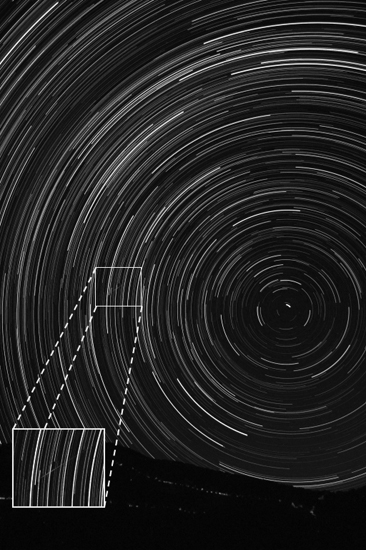Around midnight a couple of weeks ago, a fireball slipped like a flare down over my firs in Troy. It was as bright as Venus and left a faint bushy trail for two or three seconds.
It took me by surprise, but shouldn’t have, really, because mid-December is the time of the Geminid meteor shower, which peaked this year on Dec. 13. Meteor is the astronomers’ term for a shooting star — a streak of light in the night sky that lasts a second or less, usually. Meteors are pieces of interplanetary grit, most of them smaller than your thumbnail. They fall through the Earth’s atmosphere about 10 miles per second, and friction with the air heats them up until they burst into flame, sending out eyeblink streaks of light. A fireball is a larger meteor that bursts into flame and sometimes breaks into fiery pieces, leaving a longer trail. Sometimes the trail will have an aurora-like green color.
My fireball was bright white.
The astronomers get some of their information from meteors that were too large to vaporize and ended up crashing into the Earth. After they hit the ground they’re called meteorites. Most of them originated in the asteroid belt that circles the sun between Mars and Jupiter, and are material left over from the formation of the solar system. Their chemical composition is similar to the sun’s, actually. Other meteorites are chunks that probably split off from a planet or the moon, since their composition shows signs of geological processing that must have taken place after the planet or moon formed.
Large meteorites leave craters, dozens of which (of varying geological ages) have been identified all over the world. And who knows what’s fallen into the ocean.
About 20,000 to 50,000 years ago, a hunk about 80 feet wide hit the desert near Winslow, Ariz., and blew out a mile-wide crater that’s still there intact. A few years ago, a meteorite about 5 inches wide crashed through a guy’s ceiling in Illinois and demolished his computer printer. No one was hurt.
Grit is falling out of the sky all the time, but stones large enough to create fireballs are unusual, and actual meteorite strikes are comparatively rare. It’s possible to see a stray meteor just about anytime, but the Earth regularly passes through clouds of debris that appear to be left over from comets that swept through at one time or another, and at those times meteors made of comet dust streams can be seen in relative abundance.
The Geminid meteor shower each December, for example, often has as many as 50 meteors an hour — not quite one a minute. The brightest meteor showers are usually the Leonids of mid-November, which are associated with Comet 55P/Tempel-Tuttle, and the Perseids of about the second week of August, associated with Comet 109P/Swift-Tuttle.
It’s impossible to predict how many meteors you’ll see any given year. For a little while in the early morning of Nov. 17, 1966, thousands per minute were seen, which must have been a spectacular, and maybe even disturbing, sight. Thousands of things falling out of the sky, I mean, and burning up.
The showers are named for the direction from which the meteors radiate. The Geminids come from the direction of the constellation Gemini, which you can see in the evening now to the left of Orion’s shoulder. The Leonids radiate from the direction of the constellation Leo, the Perseids from the direction of Perseus. Because of Earth’s direction through space, meteors tend to hit the atmosphere after midnight, so that’s the best time to watch for them. How many you see depends not only on the abundance of the shower, but also the phase of the moon — little streaks of light get lost in moonlight.
Another bump in meteor sightings will occur next week during the Quadrantids shower, which peaks the early morning of Thursday, Jan. 3. The Quadrantids are not usually as numerous as the Perseids or Leonids, and this year the moon will be in a waning gibbous phase, so there will be moonlight after midnight. The Quadrantids, by the way, are named for a constellation no longer recognized, Quadrans Muralis; it’s the region just off the handle of the Big Dipper among stars now officially assigned to the constellations Bootes and Draco, the Dragon.
If you spot any fireballs over your tree line, let me know.
Dana Wilde lives in Troy. The Backyard Naturalist appears the second and fourth Thursday of the month. Wilde’s writings on space and time are collected in “Nebulae: A Backyard Cosmography,” available from Booklocker.com. You can contact him at naturalist@dwildepress.net.
Send questions/comments to the editors.




Success. Please wait for the page to reload. If the page does not reload within 5 seconds, please refresh the page.
Enter your email and password to access comments.
Hi, to comment on stories you must . This profile is in addition to your subscription and website login.
Already have a commenting profile? .
Invalid username/password.
Please check your email to confirm and complete your registration.
Only subscribers are eligible to post comments. Please subscribe or login first for digital access. Here’s why.
Use the form below to reset your password. When you've submitted your account email, we will send an email with a reset code.